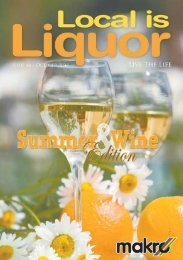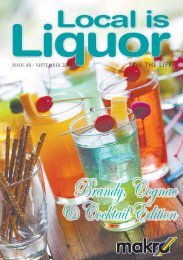Create successful ePaper yourself
Turn your PDF publications into a flip-book with our unique Google optimized e-Paper software.
An<strong>to</strong>ine Amedee Paychaud was the<br />
son of French plantation owners who<br />
fled what is now Ha<strong>it</strong>i. He grew up<br />
<strong>to</strong> be an apothecary in New Orleans<br />
w<strong>it</strong>h a s<strong>to</strong>refront on Royal Street. He<br />
opened his s<strong>to</strong>re in 1834 and quickly<br />
realized that a dose of liquor might<br />
<strong>make</strong> his <strong>to</strong>nics easier <strong>to</strong> ingest.<br />
His<strong>to</strong>ry says that Peychaud added<br />
small amounts of his own recipe for<br />
b<strong>it</strong>ters and served his <strong>to</strong>nic-b<strong>it</strong>ters<br />
mixture in eggcups called “coquetiers”<br />
filled w<strong>it</strong>h cognac or other French<br />
brandy. The word “coquetiers” was<br />
anglicized <strong>to</strong> bring “cocktail” in<strong>to</strong><br />
modern vocabulary. The eggcups were<br />
also thought <strong>to</strong> mark the introduction<br />
of a shot or the precursor <strong>to</strong> a jigger,<br />
now used for alcohol measurements<br />
in most drinks.<br />
The Sazerac Company of New<br />
Orleans says that by 1850, the Sazerac<br />
cocktail, made w<strong>it</strong>h Sazerac French<br />
brandy and Peychaud’s B<strong>it</strong>ters was<br />
already popular and quickly becoming<br />
the first “branded” cocktail. In 1873,<br />
the recipe for the Sazerac cocktail was<br />
altered <strong>to</strong> replace the French brandy<br />
w<strong>it</strong>h American Rye whiskey, and a<br />
dash of absinthe was added.<br />
The first printed recipe for<br />
the Sazerac Cocktail was in the<br />
1908 ed<strong>it</strong>ion of (former California<br />
Assemblyman) William Boothby’s<br />
The World’s Drinks and How <strong>to</strong> Mix<br />
Them. Shortly after the printed recipe,<br />
in 1912, absinthe was banned in the<br />
Un<strong>it</strong>ed States. Sazerac lovers were not<br />
lost for long. Herbsaint was created<br />
<strong>to</strong> fill the void. ‘Herb Sainte” is the<br />
New Orleanian term for wormwood,<br />
which was the ingredient in absinthe<br />
that gave <strong>it</strong> the mystique and negative<br />
reputation. Wormwood was also the ingredient<br />
absent in herbsaint that made the subst<strong>it</strong>ution legal.<br />
Even <strong>to</strong>day, w<strong>it</strong>h the legalization of absinthe, many<br />
bartenders continue <strong>to</strong> use herbsaint in the production<br />
of Sazeracs.<br />
Sazeracs are important <strong>to</strong> New Orleans because<br />
they represent the c<strong>it</strong>y in many ways. B<strong>it</strong>ters are an<br />
acquired taste that <strong>make</strong> the drink feel exclusive,<br />
absinthe culture in New Orleans has a windy and<br />
proud his<strong>to</strong>ry which gives the drink some of that<br />
absinthe mystery, and the evolving liquor base (brandy<br />
<strong>to</strong> whiskey <strong>to</strong> occasionally bourbon) is a reflection of<br />
changing cultures and his<strong>to</strong>ry in New Orleans. Sara<br />
Rohen, in Gumbo Tales described her feeling of loss<br />
and disconnect during Hurricane Katrina. Stranded<br />
in New York, she looked for Red Beans and Rice on<br />
Mondays and did not find <strong>it</strong>, she sought out Sazeracs <strong>to</strong><br />
connect her <strong>to</strong> home, but found that the time and place<br />
fac<strong>to</strong>r left her still feeling lost. A perfect Sazerac is such<br />
a part of New Orleans that you have <strong>to</strong> be there <strong>to</strong> truly<br />
appreciate and taste <strong>it</strong>.<br />
Finally, the question of which came first, the Sazerac<br />
or the Old Fashioned is up for dispute. Many sources<br />
begin their Sazerac descriptions heralding <strong>it</strong> as the<br />
first cocktail. But if Pechaud created the cocktail in the<br />
1830’s, and the oldest printed mention of a “cocktail”<br />
w<strong>it</strong>h a recipe was in 1806 (for an Old Fashioned in The<br />
Balance and Columbia Repos<strong>it</strong>ory in Hudson, New<br />
York), then the Old Fashioned must have come first.<br />
On the other hand, how could anything be listed as<br />
a “cocktail” before the alleged invention of the word<br />
adapted from Pechaud’s eggcup or “coquetier?” The<br />
evidence leans <strong>to</strong>ward the Old Fashioned as the basic<br />
recipe the Sazerac is a mimic w<strong>it</strong>h added ingredients.<br />
No matter which came first or what brandy was<br />
used, Sazeracs are part of the New Orleans s<strong>to</strong>ry.<br />
There are companies that specialize in b<strong>it</strong>ters for<br />
Sazeracs, an entire Sazerac brand that sells all liquors<br />
including vodka and gin, and at least one Sazerac bar<br />
in New Orleans. Regardless of whether a person is a<br />
New Orleans resident or an admirer, the cocktail helps<br />
them connect <strong>to</strong> the layered his<strong>to</strong>ry and mystique of<br />
the great c<strong>it</strong>y.<br />
November 2011 WHISKY EDITION<br />
63

















